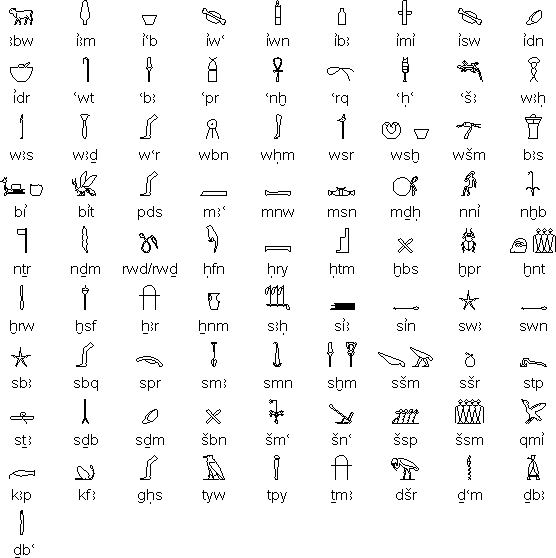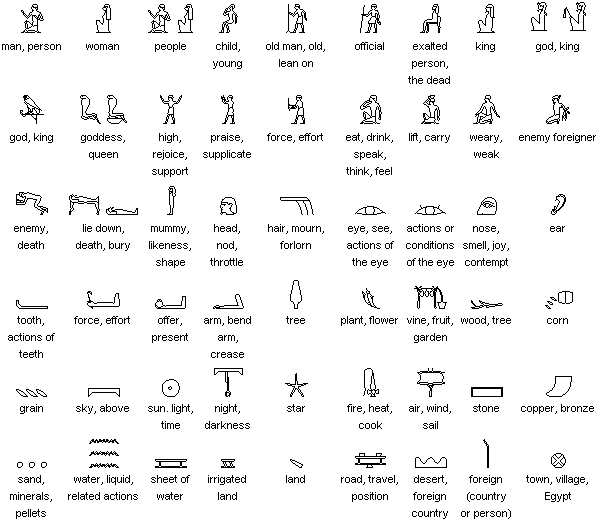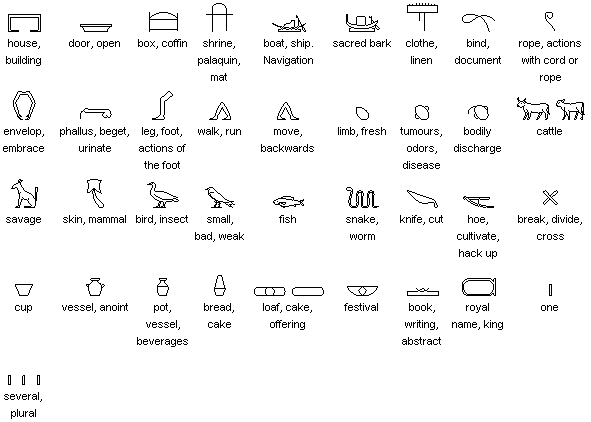
The ancient Egyptians believed that writing was invented by the god Thoth and called their hieroglyphic script "mdju netjer" ("words of the gods"). The word hieroglyph comes from the Greek hieros (sacred) plus glypho (inscriptions) and was first used by Clement of Alexandria.
The earliest known examples of writing in Egypt have been dated to 3,400 BC. The latest dated inscription in hieroglyphs was made on the gate post of a temple at Philae in 396 AD.
The hieroglyphic script was used mainly for formal inscriptions on the walls of temples and tombs. In some inscriptions the glyphs are very detailed and in full colour, in others they are simple outlines. For everyday writing the hieratic script was used.
After the Emperor Theodsius I ordered the closure of all pagan temples throughout the Roman empire in the late 4th century AD, knowledge of the hieroglyphic script was lost.
Many people have attempted to decipher the Egyptian scripts since the 5th century AD, when Horapollo provided explanations of nearly two hundred glyphs, some of which were correct. Other decipherment attempts were made in the 9th and 10th by Arab historians Dhul-Nun al-Misri and Ibn Wahshiyya, and in the 17th century by Athanasius Kircher. These attempts were all based on the mistaken assumption that the hieroglyphs represented ideas and not sounds of a particular language.
The discovery, in 1799, of the Rosetta Stone, a bilingual text in Greek and the Egyptian Hieroglyphic and Demotic scripts enabled scholars such as Silvestre de Sacy, Johan David Åkerblad and Thomas Young to make real progress with their decipherment efforts, and by the 1820s Jean-François Champollion had made the complete decipherment of the Hieroglyphic script. He realised that the Coptic language, a descendent of Ancient Egyptian used as a liturgical language in the Coptic Church in Egypt, could be used to help understand the language of the hieroglyphic inscriptions.

Egyptian, an Afro-Asiatic language spoken in Egypt until about the 10th century AD. After that it continued to be used as a the liturgical language of Egyptian Christians, the Copts, in the form of Coptic.
These glyphs alone could be used to write Ancient Egyptian and represent the first alphabet ever divised. In practice, they were rarely used in the fashion.
![]()


Determinatives are non-phonetic glyphs which give extra information about the meanings of words, distinguish homophones and serve as word dividers.


By combining the following glyphs, any number could be constructed. The higher value signs were always written in front of the lower value ones.

![]()
Transliteration: iw wnm msh nsw, this means "The crocodile eats the king".

All human beings are born free and equal in dignity and rights. They are endowed with reason and conscience and should act towards one another in a spirit of brotherhood.
(Article 1 of the Universal Declaration of Human Rights)
Ancient Egyptian language and Hieroglyphs | Hieratic script | Demotic script | Coptic alphabet | Links | Books about Ancient Egyptian
Akkadian Cuneiform, Ancient Egyptian (Demotic), Ancient Egyptian (Hieratic), Ancient Egyptian (Hieroglyphs), Chinese, Chữ-nôm, Cuneiform, Japanese, Jurchen, Khitan, Linear B, Luwian, Mayan, Naxi, Sawndip (Old Zhuang), Sui, Sumerian Cuneiform, Tangut (Hsihsia)
Page last modified: 15.03.23
[top]
You can support this site by Buying Me A Coffee, and if you like what you see on this page, you can use the buttons below to share it with people you know.

If you like this site and find it useful, you can support it by making a donation via PayPal or Patreon, or by contributing in other ways. Omniglot is how I make my living.
Note: all links on this site to Amazon.com, Amazon.co.uk
and Amazon.fr
are affiliate links. This means I earn a commission if you click on any of them and buy something. So by clicking on these links you can help to support this site.
[top]